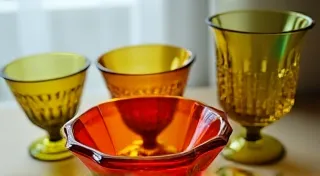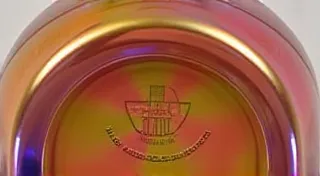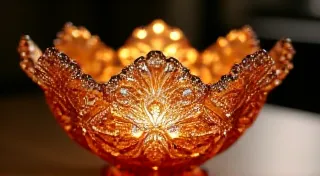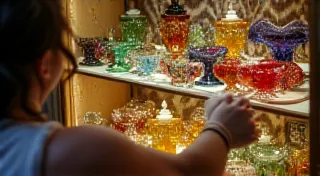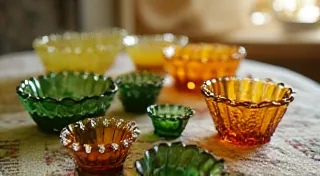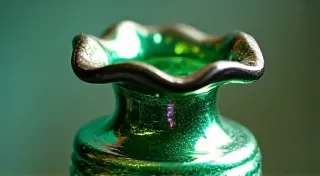Identifying Carnival Glass Colors: From Emerald Green to Vaseline
Carnival glass, a dazzling and beloved collectible, is known as much for its vibrant colors as it is for its iridescence. While the shimmering surface is a defining characteristic, understanding the underlying colors is crucial for identification, appreciation, and successful collecting. This article will delve into the spectrum of carnival glass colors, exploring how they were created and highlighting some of the most recognizable hues. Many collectors are fascinated by the history and production methods behind these beautiful pieces – you can learn more about carnival glass history and manufacturing processes to gain a deeper understanding of the craft. The complexity of the process, and the artistry involved, is what makes each piece unique.
The Science Behind the Color
The vibrant colors of carnival glass aren't pigments applied to the glass’s surface. Instead, they originate from a combination of factors related to the glass's composition and manufacturing process. Primarily, a thin layer of metallic oxides (typically including gold chloride, copper, and iron) is applied to the surface of the glass during manufacturing. This layer isn's evenly distributed. During the firing process, this metallic layer is partially volatilized, creating a rainbow-like effect when light interacts with the glass. The initial color of the base glass also influences the final appearance, and the temperature and firing conditions significantly impact the iridescence. The precise control required to achieve certain color combinations underscores the skill of the glassmakers. The interaction of these factors leads to the dazzling iridescence that defines carnival glass.
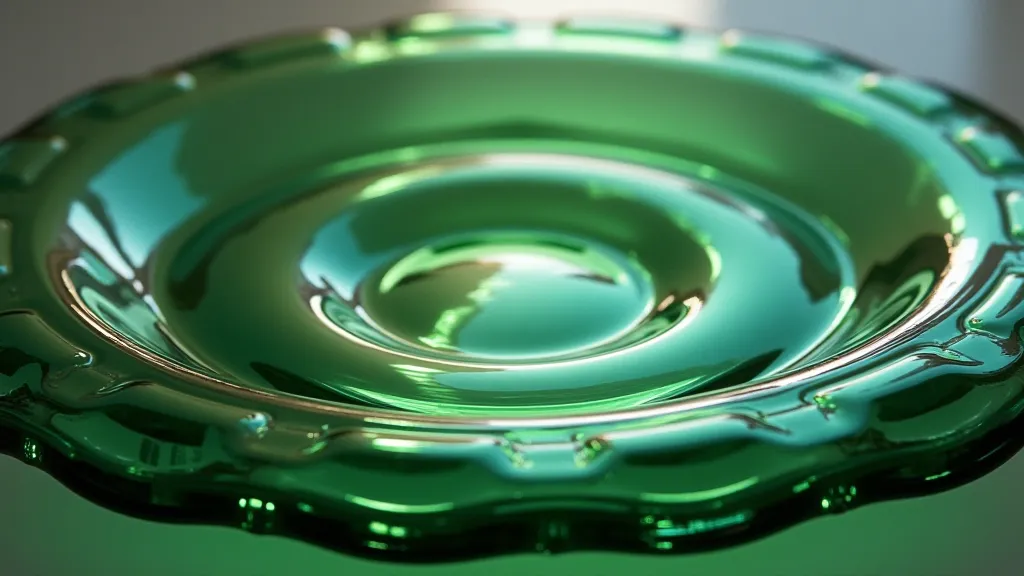
Common Carnival Glass Colors: A Detailed Look
Let's examine some of the most prevalent and sought-after carnival glass colors:
Emerald Green
Perhaps the most iconic and instantly recognizable carnival glass color is emerald green. Often referred to simply as "green," it’s characterized by its depth and richness. The base glass typically had an olive-green tint, which interacted with the metallic surface to create the final emerald appearance. Excellent examples exhibit a strong, consistent iridescence. The perceived value often reflects the intensity and uniformity of this iridescence, making it a highly desirable color among collectors.
Vaseline Glass (Butter Yellow)
Vaseline glass, also known as butter yellow or uranium glass, gets its name from the vaseline-like consistency of the chemicals used in its manufacture. It contains uranium oxide, which gives it a distinctive yellow-green hue and causes it to fluoresce under a UV light (appearing a brighter green under UV). The color can range from a pale creamy yellow to a more intense golden hue. Identifying Vaseline glass can be tricky; a more in-depth look at the qualities and value of this popular color can be found in "A Deep Dive into 'Butter Yellow' Carnival Glass: Rarity and Appeal." It’s important to note that not all yellow carnival glass is Vaseline glass; careful testing is required for confirmation. The uranium content, and subsequent fluorescence, makes this color particularly fascinating, and understanding its scientific basis enhances the appreciation of its beauty. The subtle variations in tone and intensity within the butter yellow spectrum are a testament to the nuances of the manufacturing process.
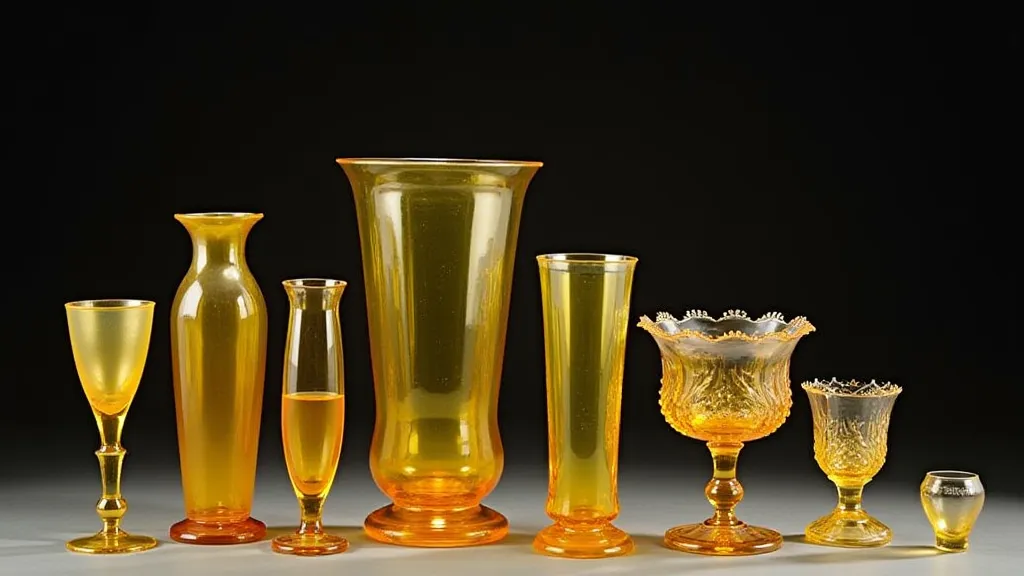
Peacock Glass
Peacock glass is famed for its stunning iridescent effect, reminiscent of the vibrant plumage of a peacock. It's typically characterized by an underlying teal or blue-green base color, overlaid with a metallic iridescence that produces shifts of blue, green, purple, and gold. The brilliance and quality of the iridescence vary greatly, with the most desirable pieces displaying a dramatic, almost three-dimensional effect. The patterns and intricacies of carnival glass are remarkable, and exploring various designs can further enrich your collecting experience. You’re encouraged to check out "Identifying Carnival Glass Patterns: A Visual Encyclopedia" for a more visual guide. Understanding the specific manufacturing techniques that lead to such dynamic color shifts adds another layer of appreciation for this breathtaking color.
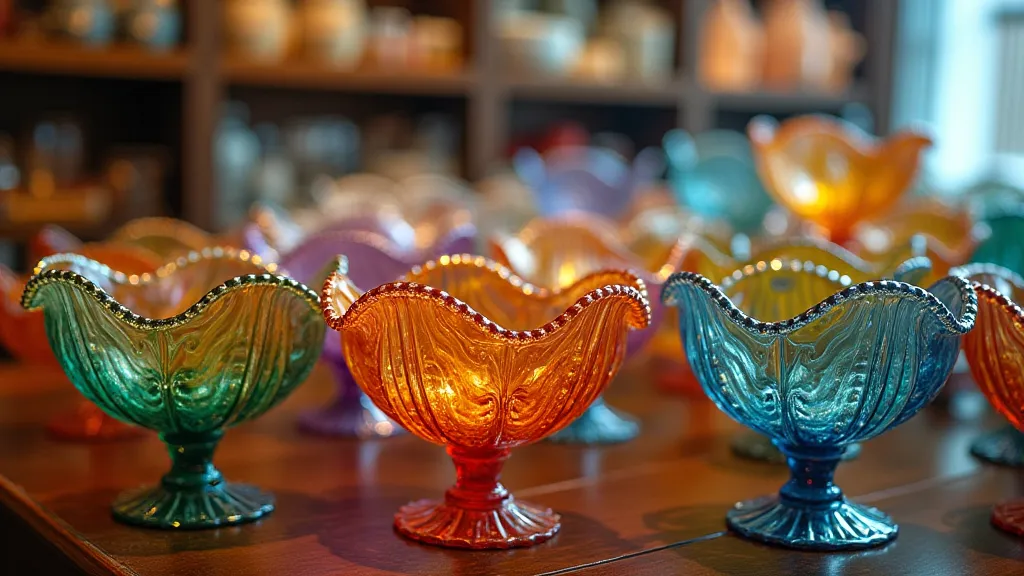
Marigold (Orange-Red)
Marigold carnival glass displays a beautiful orange-red hue, often with flashes of gold and bronze in the iridescence. It’s one of the most common colors found in various shapes and patterns. The intensity of the orange can vary considerably depending on the specific batch and firing process. Collectors often find themselves drawn to unique and unusual colors. The interplay of orange, gold, and bronze creates a warm and inviting aesthetic, making marigold carnival glass a popular choice for decorative pieces. Variations in the firing process can dramatically affect the final color, making each piece subtly different.
Amethyst/Purple
Amethyst or purple carnival glass is less common than some of the other colors but is highly prized by collectors. The purple color comes from the addition of metallic oxides, and the quality of the iridescence can vary greatly. The complexities of color creation within carnival glass represent a fascinating blend of chemistry and artistry. The subtle shifts in hue, from lavender to deep violet, add to the mystique and allure of this relatively rare color. Understanding the chemical reactions involved in producing these colors helps to appreciate the skill and ingenuity of the glassmakers.
Blue Carnival Glass
Blue carnival glass, while beautiful, is also relatively rare. Different shades of blue are seen, ranging from a soft sky blue to a deeper sapphire tone. These are usually the most expensive carnival glass pieces. The scarcity and desirability of certain colors contribute significantly to their value in the collector's market. A keen eye and a solid understanding of the manufacturing process are essential for making informed collecting decisions. The limited availability, and the challenging process of achieving consistent color, make blue carnival glass a true collector's treasure.
Distinguishing Colors & Key Takeaways
Identifying carnival glass colors can be challenging, and subtle variations often exist within each hue. Careful observation under various lighting conditions is crucial. Remember that the iridescence plays a significant role in the overall appearance, and the base glass color significantly influences the final color. Understanding not only the common colors, but also the rarer shades, can greatly enhance your appreciation for this captivating collectible. The world of carnival glass is vast and complex, and there’s always something new to discover. Delving deeper into the nuances of pattern identification can be a rewarding journey for any enthusiast. For those seeking to expand their knowledge, there are numerous resources available to aid in the identification and appreciation of these beautiful pieces.
- Lighting is key: Observe the glass under different lighting conditions.
- Base color matters: Understand the underlying base glass color.
- Iridescence varies: Appreciate the variations in iridescence quality.
- UV Light Testing: For suspected Vaseline glass, use a UV light source to confirm fluorescence.
With practice and a keen eye, you’re well on your way to accurately identifying and appreciating the beautiful spectrum of carnival glass colors! Remember that the variations in color, pattern and rarity contribute significantly to the overall appeal of carnival glass. It's a collecting hobby that rewards patience, research, and a genuine appreciation for the history and artistry behind each piece. For those truly passionate about the topic, exploring unusual colors and patterns is a worthwhile pursuit. The journey of collecting is as rewarding as the treasures themselves. Every piece has a story to tell, a history to uncover, and a beauty to celebrate.
To truly understand the depth and variety within carnival glass, it’s helpful to familiarize yourself with the different patterns commonly found. Each pattern lends a unique character to the colors, further enhancing their beauty and value. Exploring the nuances of these patterns can truly elevate your appreciation for the artistry and craftsmanship of carnival glass. Happy collecting!
